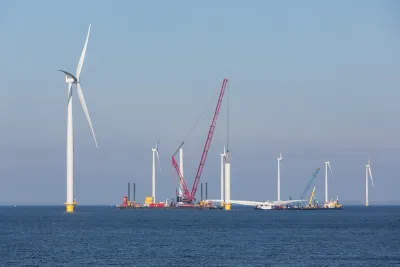Federal support for offshore wind projects is helping the industry grow, with nine projects approved so far this year.

In a piece for Sierra magazine, Sarah Giltz and Nancy Pyne highlight the growth of the offshore wind industry in the United States. “Today there are enough offshore wind projects moving forward to power nearly 5 million homes,” Giltz and Pyne write.
According to the authors, a new plan from the Department of the Interior “increases transparency and predictability and creates greater regulatory certainty for offshore wind,” while other federal agencies are also working to develop policy recommendations and modernize renewable energy infrastructure. “By 2030, offshore wind is expected to create 77,000 family-sustaining jobs, support thousands of small businesses, and inject hundreds of millions of dollars in local communities.”
The authors emphasize the need for project labor agreements to ensure that the industry provides stable, high-quality jobs. “It’s clear that partnerships are key as developers, unions, conservation organizations and communities work to build this new industry together. Collaboration will be essential to build on the current momentum and ensure the offshore wind industry creates good jobs and provides real benefits to local communities.”
FULL STORY: Offshore Wind Development in the US is Reaching Gale Force

National Parks Layoffs Will Cause Communities to Lose Billions
Thousands of essential park workers were laid off this week, just before the busy spring break season.

Retro-silient?: America’s First “Eco-burb,” The Woodlands Turns 50
A master-planned community north of Houston offers lessons on green infrastructure and resilient design, but falls short of its founder’s lofty affordability and walkability goals.

Delivering for America Plan Will Downgrade Mail Service in at Least 49.5 Percent of Zip Codes
Republican and Democrat lawmakers criticize the plan for its disproportionate negative impact on rural communities.

Test News Post 1
This is a summary

Test News Headline 46
Test for the image on the front page.

Balancing Bombs and Butterflies: How the National Guard Protects a Rare Species
The National Guard at Fort Indiantown Gap uses GIS technology and land management strategies to balance military training with conservation efforts, ensuring the survival of the rare eastern regal fritillary butterfly.
Urban Design for Planners 1: Software Tools
This six-course series explores essential urban design concepts using open source software and equips planners with the tools they need to participate fully in the urban design process.
Planning for Universal Design
Learn the tools for implementing Universal Design in planning regulations.
EMC Planning Group, Inc.
Planetizen
Planetizen
Mpact (formerly Rail~Volution)
Great Falls Development Authority, Inc.
HUDs Office of Policy Development and Research
NYU Wagner Graduate School of Public Service





























